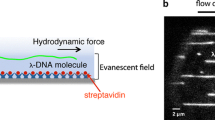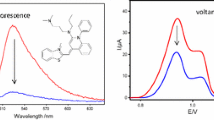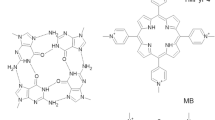Abstract
In this study, we have investigated the fluorescence properties of SYBR Green I (SG) dye and its interaction with double-stranded DNA (dsDNA). SG/dsDNA complexes were studied using various spectroscopic techniques, including fluorescence resonance energy transfer and time-resolved fluorescence techniques. It is shown that SG quenching in the free state has an intrinsic intramolecular origin; thus, the observed >1,000-fold SG fluorescence enhancement in complex with DNA can be explained by a dampening of its intra-molecular motions. Analysis of the obtained SG/DNA binding isotherms in solutions of different ionic strength and of SG/DNA association in the presence of a DNA minor groove binder, Hoechst 33258, revealed multiple modes of interaction of SG inner groups with DNA. In addition to interaction within the DNA minor groove, both intercalation between base pairs and stabilization of the electrostatic SG/DNA complex contributed to increased SG affinity to double-stranded DNA. We show that both fluorescence and the excited state lifetime of SG dramatically increase in viscous solvents, demonstrating an approximate 200-fold enhancement in 100 % glycerol, compared to water, which also makes SG a prospective fluorescent viscosity probe. A proposed structural model of the SG/DNA complex is compared and discussed with results recently reported for the closely related PicoGreen chromophore.











Similar content being viewed by others
Abbreviations
- SG:
-
SYBR Green I
- PG:
-
PicoGreen
- MEF:
-
Metal-Enhanced Fluorescence
- FCS:
-
Fluorescence Correlation Spectroscopy
- FRET:
-
Fluorescence Resonance Energy Transfer
References
Ahn SJ, Costa J, Emanuel JR (1996) PicoGreen quantitation of DNA: effective evaluation of samples pre- or post-PCR (vol 24, pg 2623, 1996). Nucleic Acids Res 24:3282
Becker A, Reith A, Napiwotzki J, Kadenbach B (1996) A quantitative method of determining initial amounts of DNA by polymerase chain reaction cycle titration using digital imaging and a novel DNA stain. Anal Biochem 237:204–207
Blaheta RA, Kronenberger B, Woitaschek D, Weber S, Scholz M, Schuldes H, Encke A, Markus BH (1998) Development of an ultrasensitive in vitro assay to monitor growth of primary cell cultures with reduced mitotic activity. J Immunol Methods 211:159–169
Choi SJ, Szoka FC (2000) Fluorometric determination of deoxyribonuclease I activity with PicoGreen. Anal Biochem 281:95–97
Dragan AI, Bishop ES, Casas-Finet JR, Strouse RJ, Schenerman MA, Geddes CD (2010) Metal-enhanced PicoGreen fluorescence: application for double-stranded DNA quantification. Anal Biochem 396:8–12
Murakami P, McCaman MT (1999) Quantitation of adenovirus DNA and virus particles with the PicoGreen fluorescent dye. Anal Biochem 274:283–288
Noothi SK, Kombrabail M, Rao BJ, Krishnamoorthy G (2009) Fluorescence characterization of the structural heterogeneity of polytene chromosomes. J Fluoresc
Noothi SK, Kombrabail M, Kundu TK, Krishnamoorthy G, Rao BJ (2009) Enhanced DNA dynamics due to cationic reagents, topological states of dsDNA and high mobility group box 1 as probed by PicoGreen. FEBS J 276:541–551
Schneeberger C, Speiser P, Kury F, Zeillinger R (1995) Quantitative detection of reverse transcriptase-pcr products by means of a novel and sensitive DNA stain. PCR Methods Appl 4:234–238
Singer VL, Jones LJ, Yue ST, Haugland RP (1997) Characterization of PicoGreen reagent and development of a fluorescence-based solution assay for double-stranded DNA quantitation. Anal Biochem 249:228–238
Zipper H, Brunner H, Bernhagen J, Vitzthum F (2004) Investigations on DNA intercalation and surface binding by SYBR Green I, its structure determination and methodological implications. Nucleic Acids Res 32:e103
Ikeda Y, Iwakiri S, Yoshimori T (2009) Development and characterization of a novel host cell DNA assay using ultra-sensitive fluorescent nucleic acid stain “PicoGreen”. J Pharm Biomed Anal 49:997–1002
Geddes CD, Lakowicz JR (2002) Metal-enhanced fluorescence. J Fluoresc 12:121–129
Dragan AI, Casas-Finet JR, Bishop ES, Strouse RJ, Schenerman MA, Geddes CD (2010) Characterization of PicoGreen interaction with dsDNA and the origin of its fluorescence enhancement upon binding. Biophys J 99:3010–3019
Singer VL, Jones LJ, Yue ST, Haugland RP (1997) Characterization of PicoGreen reagent and development of a fluorescence-based solution assay for double-stranded DNA quantitation. Anal Biochem 249:228–238
Dragan AI, Carrillo R, Gerasimova TI, Privalov PL (2008) Assembling the human IFN-beta enhanceosome in solution. J Mol Biol 384:335–348
Lakowicz JR (2006) Principles of fluorescence spectroscopy. Springer Science + Business Media, LLC, New York
Cosa G, Focsaneanu KS, McLean JR, McNamee JP, Scaiano JC (2001) Photophysical properties of fluorescent DNA-dyes bound to single- and double-stranded DNA in aqueous buffered solution. Photochem Photobiol 73:585–599
McGhee JD, von Hippel PH (1974) Theoretical aspects of DNA-protein interactions: co-operative and non-co-operative binding of large ligands to a one-dimensional homogeneous lattice. J Mol Biol 86:469–489
Lakowicz JR, Weber G (1973) Quenching of fluorescence by oxygen. A probe for structural fluctuations in macromolecules. Biochemistry 12:4161–4170
Le Pecq JB, Paoletti CA (1967) A fluorescent complex between ethidium bromide and nucleic acids: physical-chemical characterization. J Mol Biol 27:87–106
Morgan AR, Lee JS, Pulleyblank DE, Murray NL, Evans DH (1979) Review: ethidium fluorescence assays. Part 1. Physicochemical studies. Nucleic Acids Res 7:547–569
Olmsted J III, Kearns DR (1977) Mechanism of ethidium bromide fluorescence enhancement on binding to nucleic acids. Biochemistry 16:3647–3654
Crane-Robinson C, Dragan AI, Privalov PL (2006) The extended arms of DNA-binding domains: a tale of tails. Trends Biochem Sci 31:547–552
Dragan AI, Read CM, Makeyeva EN, Milgotina EI, Churchill ME, Crane-Robinson C, Privalov PL (2004) DNA binding and bending by HMG boxes: energetic determinants of specificity. J Mol Biol 343:371–393
Privalov PL, Dragan AI, Crane-Robinson C, Breslauer KJ, Remeta DP, Minetti CA (2007) What drives proteins into the major or minor grooves of DNA? J Mol Biol 365:1–9
Dragan AI, Liggins JR, Crane-Robinson C, Privalov PL (2003) The energetics of specific binding of AT-hooks from HMGA1 to target DNA. J Mol Biol 327:393–411
Record MT Jr, Anderson CF, Lohman TM (1978) Thermodynamic analysis of ion effects on the binding and conformational equilibria of proteins and nucleic acids: the roles of ion association or release, screening, and ion effects on water activity. Q Rev Biophys 11:103–178
Record MT Jr, Zhang W, Anderson CF (1998) Analysis of effects of salts and uncharged solutes on protein and nucleic acid equilibria and processes: a practical guide to recognizing and interpreting polyelectrolyte effects, Hofmeister effects, and osmotic effects of salts. Adv Protein Chem 51:281–353
Manning GS (1978) The molecular theory of polyelectrolyte solutions with applications to the electrostatic properties of polynucleotides. Q Rev Biophys 11:179–246
Privalov PL, Dragan AI, Crane-Robinson C (2011) Interpreting protein/DNA interactions: distinguishing specific from non-specific and electrostatic from non-electrostatic components. Nucleic Acids Res. Feb 8, doi:10.1093/nar/gkq984
Haq I, Ladbury JE, Chowdhry BZ, Jenkins TC, Chaires JB (1997) Specific binding of hoechst 33258 to the d(CGCAAATTTGCG)2 duplex: calorimetric and spectroscopic studies. J Mol Biol 271:244–257
Utsuno K, Maeda Y, Tsuboi M (1999) How and how much can Hoechst 33258 cause unwinding in a DNA duplex? Chem Pharm Bull(Tokyo) 47:1363–1368
Pjura PE, Grzeskowiak K, Dickerson RE (1987) Binding of Hoechst 33258 to the minor groove of B-DNA. J Mol Biol 197:257–271
Carlsson C, Larsson A, Jonsson M, Albinsson B, Norden B (1994) Optical and photophysical properties of the oxazole yellow DNA probes Yo and YoYo. J Phys Chem 98:10313–10321
Acknowledgments
The authors would like to thank MedImmune for financial support. Support from the Institute of Fluorescence, Department of Chemistry and Biochemistry and UMBC is also gratefully acknowledged.
Author information
Authors and Affiliations
Corresponding author
Rights and permissions
About this article
Cite this article
Dragan, A.I., Pavlovic, R., McGivney, J.B. et al. SYBR Green I: Fluorescence Properties and Interaction with DNA. J Fluoresc 22, 1189–1199 (2012). https://doi.org/10.1007/s10895-012-1059-8
Received:
Accepted:
Published:
Issue Date:
DOI: https://doi.org/10.1007/s10895-012-1059-8




